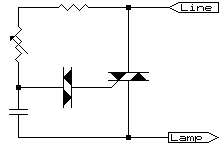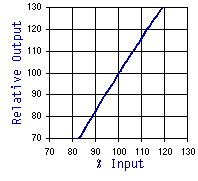|
Technology that uses the combination of a few discrete electronic components, such as resistors, capacitors, diodes, transistors, and thyristors could be classified as "simple technology". Lamp dimmers, speed controllers in food processors and washing machines, and energy saving (high-frequency) lamps all fall into this category. The classification of "simple" is not intended to indicate that the electronics used is not vital to the operation. It is merely indicating that that the amount of electronics used is small. Should the thyristor fail in a lamp dimmer or speed controller then either things are bright and wanting to take off, or in darkness and standing still. The top-end in this class is energy saving lamps that use discrete components. Anything more intricate, or anything that uses integrated circuits, would undoubtedly be classed as "semi-complex" or "complex" technology. There are two distinct issues where light dimmers are renowned for causing modern power quality problems being buzzing audio on hi-fi systems and exaggerated flicker. Both are directly related to the operation of the standard dimmer which controls the mark-space ratio of the cycle.
However, the voltage present at the input to the circuit will also affect the speed at which the cap is charged, and will therefore affect the mark-pace ratio of the cycle. If flicker is a problem, light dimmers will almost certainly exaggerate it owing to the fact that with a voltage drop comes an unfavourable change in mark-space ratio resulting in the lamp having a two-fold lowering of working voltage. The first being the lowering of the input voltage as well as a reduced mark-space ratio (on for less time) both lowering the output RMS - all this to the annoyance of the user.
As was seen in the section "Flickering Lights", a Just Noticable Difference in brilliance required only a change of approximately 0.7% or 1.6V at 230V nominal. With the dimmer added the change required now is less than 0.4% or 0.9V at 230V nominal. A further exaggeration with regards flicker is the potentiometer used in most household dimmer units. As with an old radio developing a scratchy volume control; This same type of component is used in most dimmers and should there be any wear-and-tear the lights could change brilliance all on their own. A light dimmer creating interference is often found on a lighting circuit where the wiring is not laid so as to cancel the magnetic fields. The fact that the sudden rise in current is not cancelled will have all devices using magnetic coupling susceptible to this fast changing field. Tape recorders, magnetic phono cartridges, and even video tape recorders can be sensitive to this. Although EMC filters are installed in most dimmers, these are only really effective from a few hundred kHz up. If the filters were to be affective in the audio range then the dimmer would dissipate too much heat. Very old dimmers have been known to not have such EMC filters making them prime candidates for emitting radio frequency interference too.
© 17.04.02 |
 CAUSES:
CAUSES: A circuit for a dimmer is shown alongside (less all EMC filters etc.). The basic operation is the capacitor is charged at a speed controlled by the potentiometer. When it reaches the breakdown value of the diac, the charge in the cap is fed into the gate of the triac which turns on. The time taken for the triac to be turned on is therefore relative to the speed at which the cap is charged, this relative to the setting of the potentiometer.
A circuit for a dimmer is shown alongside (less all EMC filters etc.). The basic operation is the capacitor is charged at a speed controlled by the potentiometer. When it reaches the breakdown value of the diac, the charge in the cap is fed into the gate of the triac which turns on. The time taken for the triac to be turned on is therefore relative to the speed at which the cap is charged, this relative to the setting of the potentiometer.  The graph to the right is the relationship of input vs. output of a typical dimmer when set at 70% RMS output. It is clearly seen the output follows the input at about 1.8:1 ratio, or in lamp terms (as brightness is approximately equal to V2) >3:1 i.e. a 10% change in voltage could be perceived as a brilliance change of greater than 30%.
The graph to the right is the relationship of input vs. output of a typical dimmer when set at 70% RMS output. It is clearly seen the output follows the input at about 1.8:1 ratio, or in lamp terms (as brightness is approximately equal to V2) >3:1 i.e. a 10% change in voltage could be perceived as a brilliance change of greater than 30%.